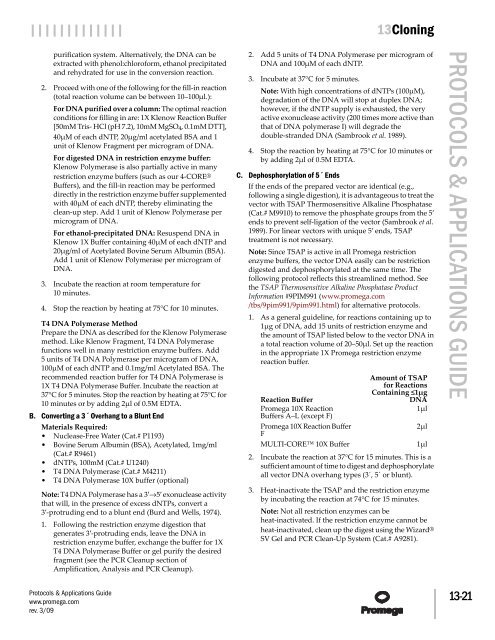Protocols and Applications Guide (US Letter Size) - Promega
Protocols and Applications Guide (US Letter Size) - Promega
Protocols and Applications Guide (US Letter Size) - Promega
Create successful ePaper yourself
Turn your PDF publications into a flip-book with our unique Google optimized e-Paper software.
||||||||||||| 13Cloning<br />
purification system. Alternatively, the DNA can be<br />
extracted with phenol:chloroform, ethanol precipitated<br />
<strong>and</strong> rehydrated for use in the conversion reaction.<br />
2. Proceed with one of the following for the fill-in reaction<br />
(total reaction volume can be between 10–100µl.):<br />
For DNA purified over a column: The optimal reaction<br />
conditions for filling in are: 1X Klenow Reaction Buffer<br />
[50mM Tris- HCl (pH 7.2), 10mM MgSO4, 0.1mM DTT],<br />
40µM of each dNTP, 20µg/ml acetylated BSA <strong>and</strong> 1<br />
unit of Klenow Fragment per microgram of DNA.<br />
For digested DNA in restriction enzyme buffer:<br />
Klenow Polymerase is also partially active in many<br />
restriction enzyme buffers (such as our 4-CORE®<br />
Buffers), <strong>and</strong> the fill-in reaction may be performed<br />
directly in the restriction enzyme buffer supplemented<br />
with 40µM of each dNTP, thereby eliminating the<br />
clean-up step. Add 1 unit of Klenow Polymerase per<br />
microgram of DNA.<br />
For ethanol-precipitated DNA: Resuspend DNA in<br />
Klenow 1X Buffer containing 40µM of each dNTP <strong>and</strong><br />
20µg/ml of Acetylated Bovine Serum Albumin (BSA).<br />
Add 1 unit of Klenow Polymerase per microgram of<br />
DNA.<br />
3. Incubate the reaction at room temperature for<br />
10 minutes.<br />
4. Stop the reaction by heating at 75°C for 10 minutes.<br />
T4 DNA Polymerase Method<br />
Prepare the DNA as described for the Klenow Polymerase<br />
method. Like Klenow Fragment, T4 DNA Polymerase<br />
functions well in many restriction enzyme buffers. Add<br />
5 units of T4 DNA Polymerase per microgram of DNA,<br />
100µM of each dNTP <strong>and</strong> 0.1mg/ml Acetylated BSA. The<br />
recommended reaction buffer for T4 DNA Polymerase is<br />
1X T4 DNA Polymerase Buffer. Incubate the reaction at<br />
37°C for 5 minutes. Stop the reaction by heating at 75°C for<br />
10 minutes or by adding 2µl of 0.5M EDTA.<br />
B. Converting a 3´ Overhang to a Blunt End<br />
Materials Required:<br />
• Nuclease-Free Water (Cat.# P1193)<br />
• Bovine Serum Albumin (BSA), Acetylated, 1mg/ml<br />
(Cat.# R9461)<br />
• dNTPs, 100mM (Cat.# U1240)<br />
• T4 DNA Polymerase (Cat.# M4211)<br />
• T4 DNA Polymerase 10X buffer (optional)<br />
Note: T4 DNA Polymerase has a 3′→5′ exonuclease activity<br />
that will, in the presence of excess dNTPs, convert a<br />
3′-protruding end to a blunt end (Burd <strong>and</strong> Wells, 1974).<br />
1. Following the restriction enzyme digestion that<br />
generates 3′-protruding ends, leave the DNA in<br />
restriction enzyme buffer, exchange the buffer for 1X<br />
T4 DNA Polymerase Buffer or gel purify the desired<br />
fragment (see the PCR Cleanup section of<br />
Amplification, Analysis <strong>and</strong> PCR Cleanup).<br />
<strong>Protocols</strong> & <strong>Applications</strong> <strong>Guide</strong><br />
www.promega.com<br />
rev. 3/09<br />
2. Add 5 units of T4 DNA Polymerase per microgram of<br />
DNA <strong>and</strong> 100µM of each dNTP.<br />
3. Incubate at 37°C for 5 minutes.<br />
Note: With high concentrations of dNTPs (100µM),<br />
degradation of the DNA will stop at duplex DNA;<br />
however, if the dNTP supply is exhausted, the very<br />
active exonuclease activity (200 times more active than<br />
that of DNA polymerase I) will degrade the<br />
double-str<strong>and</strong>ed DNA (Sambrook et al. 1989).<br />
4. Stop the reaction by heating at 75°C for 10 minutes or<br />
by adding 2µl of 0.5M EDTA.<br />
C. Dephosphorylation of 5´ Ends<br />
If the ends of the prepared vector are identical (e.g.,<br />
following a single digestion), it is advantageous to treat the<br />
vector with TSAP Thermosensitive Alkaline Phosphatase<br />
(Cat.# M9910) to remove the phosphate groups from the 5′<br />
ends to prevent self-ligation of the vector (Sambrook et al.<br />
1989). For linear vectors with unique 5′ ends, TSAP<br />
treatment is not necessary.<br />
Note: Since TSAP is active in all <strong>Promega</strong> restriction<br />
enzyme buffers, the vector DNA easily can be restriction<br />
digested <strong>and</strong> dephosphorylated at the same time. The<br />
following protocol reflects this streamlined method. See<br />
the TSAP Thermosensitive Alkaline Phosphatase Product<br />
Information #9PIM991 (www.promega.com<br />
/tbs/9pim991/9pim991.html) for alternative protocols.<br />
1. As a general guideline, for reactions containing up to<br />
1µg of DNA, add 15 units of restriction enzyme <strong>and</strong><br />
the amount of TSAP listed below to the vector DNA in<br />
a total reaction volume of 20–50µl. Set up the reaction<br />
in the appropriate 1X <strong>Promega</strong> restriction enzyme<br />
reaction buffer.<br />
Reaction Buffer<br />
<strong>Promega</strong> 10X Reaction<br />
Buffers A–L (except F)<br />
<strong>Promega</strong> 10X Reaction Buffer<br />
F<br />
MULTI-CORE 10X Buffer<br />
Amount of TSAP<br />
for Reactions<br />
Containing ≤1µg<br />
DNA<br />
1µl<br />
2µl<br />
1µl<br />
2. Incubate the reaction at 37°C for 15 minutes. This is a<br />
sufficient amount of time to digest <strong>and</strong> dephosphorylate<br />
all vector DNA overhang types (3´, 5´ or blunt).<br />
3. Heat-inactivate the TSAP <strong>and</strong> the restriction enzyme<br />
by incubating the reaction at 74°C for 15 minutes.<br />
Note: Not all restriction enzymes can be<br />
heat-inactivated. If the restriction enzyme cannot be<br />
heat-inactivated, clean up the digest using the Wizard®<br />
SV Gel <strong>and</strong> PCR Clean-Up System (Cat.# A9281).<br />
PROTOCOLS & APPLICATIONS GUIDE 13-21
















